A study by the Arts Education
Research Center at NYU has shown that achievement test scores
in academic subjects improve when the
arts are used to assist learning in mathematics, creative
writing, and communication skills. This seems likely because so
many concepts have interdisciplinary
importance to both of these disciplines. In order to appreciate how critical
mathematics is in the study of visual art, consider the In producing or understanding
a line, it may be necessary
to measure length, width
(and maybe even thickness), angle
in degrees, "Mathematics" is a plural
form but takes a singular verb. Although in mathematics the word "figure" stands for a number, in art
it stands for a person or object.
[That's noteworthy, don't you think?!] Examples of art incorporating
applications of mathematics: In the upper right of Dürer's engraving,
just below a bell, he placed a 
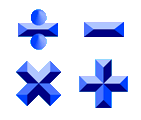 combinations, generalizations, and
abstractions -- and of shapes,
forms, and spaces
-- their
structure, measurement,
transformations, and generalizations.
The science of numbers.
It uses signs, symbols,
and proofs, and includes arithmetic, algebra, calculus, geometry,
and trigonometry. Mathematics is also the performace of calculations
-- the calculations involved in a process,
estimate, or plan of action, using reason and usually a special
system of symbols and rules for
organizing them.
combinations, generalizations, and
abstractions -- and of shapes,
forms, and spaces
-- their
structure, measurement,
transformations, and generalizations.
The science of numbers.
It uses signs, symbols,
and proofs, and includes arithmetic, algebra, calculus, geometry,
and trigonometry. Mathematics is also the performace of calculations
-- the calculations involved in a process,
estimate, or plan of action, using reason and usually a special
system of symbols and rules for
organizing them.
 importance of regular
and irregular shapes (the circle,
ovals, and polygons
for instance) and forms (sphere,
polyhedrons, etc.), in
being able to draw, paint,
or sculpt them, sometimes one
must use mathematical formulae and procedures to calculate or
measure their dimensions,
area, or volume. In order
to cast a form in a metal, one must know the temperature of its melting
point. One must understand proportions
in order to represent
nature without
distortion.
importance of regular
and irregular shapes (the circle,
ovals, and polygons
for instance) and forms (sphere,
polyhedrons, etc.), in
being able to draw, paint,
or sculpt them, sometimes one
must use mathematical formulae and procedures to calculate or
measure their dimensions,
area, or volume. In order
to cast a form in a metal, one must know the temperature of its melting
point. One must understand proportions
in order to represent
nature without
distortion.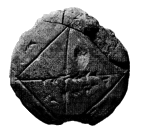
Babylon, Inscription Representing the Square Root of 2,
1st or 2nd millennium
BCE,
stone tablet,
Yale U, Princeton, NJ. See inscription.
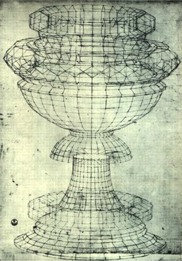
Paolo Uccello (born Paolo di Dono) (Italian,
1397-1475), Perspective
Study of a Chalice, pen
and ink on paper,
29 x 24.5 cm, Gabinetto dei Disegni, Uffizi, Florence. See linear perspective, Renaissance, and wireframe.
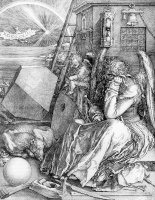
Albrecht Dürer (German, 1471-1528),
Melancholia
1, 1514, copper plate
engraving,
25 x 19 cm. This picture is loaded with mathematical instruments
and symbols as an angel broods over the
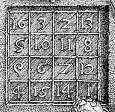 nature of the universe.
nature of the universe."magic square." There are many
versions of this mathematical puzzle. This one can be decoded
as "1514," the year Dürer witnessed the appearance
of a bright comet at the same moment that a deadly plague was
sweeping across Europe; the year the artist produced this design. Here's
a link to an explanation of how the magic square works.

Architect Charles E. Jeanneret, known as
"Le Corbusier" (French, 1887-1965), often used golden
rectangles in his designs
for buildings. One of these is the United Nations building in
New York. The dimensions
of the upright part of the L has sides in a specific proportion
called the Golden
Mean or Golden
Section -- a specific mathematical relationship of one side's
length to the other --
and there are distinctive marks on this taller part which again
divide the height of the
building in a display of this special mathematical relationship.
The Golden Mean produces a harmonic
effect called eurythmy
found in nature
as well as in a wide variety of works of art and design. Artists of various periods
and cultures have found that
dimensions determined by this formula are aesthetically
appealing. See architect.

Maurits Cornelis Escher (Dutch, 1898-1972),
Other World, 1947, color wood
engraving and woodcut
printed in black, red-brown, and green, printed from three blocks; image 12 1/2 x 10
1/4 inches (31.8 x 26.1 cm), sheet 39.2 x 32.9 cm; Fine Arts
Museums of San Francisco, CA. Depending upon which of this room's
three windows we look out, we find our point
of view is completely different and irreconsilable from each
of the others. See optical
illusion.
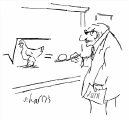
S. Harris (American, contemporary), American Scientist,
c. 2000, pen and ink
on paper. See cartoon.
![]()
Also see advocacy, accuracy, Afrocentrism, Bloom's Taxonomy, circumference, civilization, coefficient of expansion, computer graphics, diagram, diameter, digital image, digital photography, digitizing, dingbat, empirical, empiricism, equilateral, Golden Mean or Golden Section, graph, helix, linear perspective, multiple intelligence theory, numbered, numismatics, parabola, parallel, parameter, pattern, phenomenology, pi, radial and radial balance, research, science and art, sequence, standards, symmetry or symmetrical balance, technology, tessellation, theory, time, vertex, volute, and wavelength.
https://inform.quest/_art